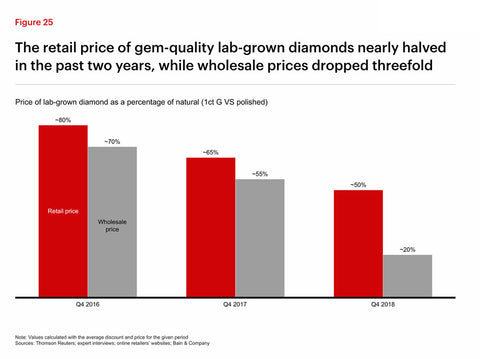If you've been in the market for a lab-grown diamond, you might have noticed some drastic price declines over the past couple of years. What exactly is happening?
The market for lab-created diamonds is eerily similar to what happened with lab-created emeralds. Emeralds were (and still are) one of the rarest precious gemstones in the world. Technology innovations allowed manufacturers to replicate a natural emerald and create a virtual copy.
When lab-created emeralds burst on the scene in the early 1990s, people were excited and jumped on the bandwagon. These synthetic emeralds popped up in jewelry all across the United States. But it didn’t stop there.
Soon after, people were buying synthetic emerald jewelry for $79 to $99. Lab-created emeralds were popular for a year or two, then the excitement faded away. You can still buy them, but they’re far from in-demand.
Is it fair to compare lab-created emeralds to diamonds? From a technical perspective, it’s hard to imagine that the price of lab-created diamonds won’t continue to plummet. There’s no cap on supply and economies of scale, and innovations in technology continue to progress. These factors will all continue to force the price down.
Overall, the price of lab-created diamonds has halved in the last two years according to a report published by Bain & Company.
Why should I care?
Lab-created diamonds are cheaper than natural diamonds but they’re a worse bang for your buck since there’s no resale value. You shouldn’t view your diamond as an investment, but you shouldn’t ignore its value entirely.
For example, let’s say an average natural diamond retains about 50% of its value after purchase. Eventually, the value of the diamond will rise (historically, diamond prices rise consistently). If you ever try to sell your diamond, you should get at least half of your original purchase price. (If that natural diamond was purchased at Chalmers, you could upgrade it and get 100% of the original value toward an upgrade).
Lab-created diamonds on the other hand, have no resale value. That means if you buy a lab-created diamond, you won’t be able to reap any part of what you paid for it. It can’t be resold to a jeweler and it won’t garner more than a few dollars on a site like eBay. From a value perspective, you’d need to buy a lab-created diamond at a massive discount to justify giving up the value retention of natural diamonds.
Let us be clear. We're not saying DON'T buy a lab-grown diamond. It might be a great solution for getting that WOW factor on a tight budget. But if you are thinking of dropping a boat load of money on one - thinking it will still have value down the road -you'll want to consider sticking to a natural diamond.



